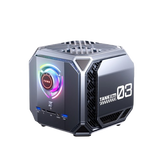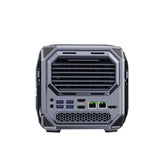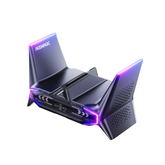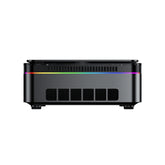Mini PC vs SFF PC: Compact Desktop Computer Comparison

Mini PC and Small Form Factor (SFF) PC have emerged as two petite computing solutions in recent years, catering to the burgeoning demand for portable, energy-efficient, and effective computing systems across residential, corporate, and commercial domains.
Mini PCs, as the name suggests, are diminutive personal computers. They typically employ low-power mobile processors, integrating motherboards, memory, storage, and other components into a compact form factor that can be as small as the palm of one's hand. Admired for their petite, tranquil, and energy-conserving attributes, Mini PCs are highly favored for applications in offices, multimedia, digital advertising, and beyond.
On the other hand, SFF PCs represent a compact computing alternative positioned between Mini PCs and traditional desktops. These systems harness desktop-grade processors and components akin to those found in conventional desktops, yet they consolidate these elements within a diminutive chassis typically ranging from 1 to 5 liters in volume. SFF PCs proffer performance and scalability akin to desktops while notably reducing spatial footprint, making them well-suited for users with demands for both performance and compactness.
This article delves into the distinctions and similarities between Mini PCs and SFF PCs, exploring their performance metrics, applicable scenarios, price-to-performance ratios, and more to furnish readers with a comprehensive understanding of the distinctive characteristics of these petite computing solutions.
Comprehending Form Factors in PCs
The form factor of small computers pertains to the physical dimensions and layout of the computer motherboard, chassis, and power supply. Understanding the various form factors is crucial for selecting a computer that aligns with one's spatial constraints and performance requisites.
Presently, the PC industry adheres to several standard form factors:
- ATX: The most prevalent full-sized desktop form factor, striking a balance between size, expandability, and heat dissipation.
- Micro-ATX: A downsized variant of ATX, offering fewer expansion slots while preserving commendable functionality and size equilibrium.
- Mini-ITX: A more diminutive form factor commonly utilized in compact casings. Given its compatibility with small enclosures, Mini-ITX motherboards are particularly prevalent in Small Form Factor (SFF) PCs.
- Small Form Factor (SFF): Encompassing various categories of compact designs.
- Micro PC: Ultra-compact systems, sometimes referred to as mini PCs or micro hosts.
Beyond the aforementioned standard form factors, small computers exhibit a plethora of other designs such as cube-shaped, sandwich-style, gaming console-like, netbook-inspired, home theater-oriented, and more. By optimizing the layout of motherboards, power supplies, and chassis, these designs compress potent hardware into remarkably confined spaces.
Moreover, modular computers (COM) and ultra-compact PCs adhere to smaller motherboard standards like Nano-ITX and Pico-ITX, further reducing volume but concurrently constraining expandability.
Understanding Small Form Factor (SFF) PCs
A Small Form Factor PC (SFF PC) is a desktop computer that is smaller in volume and footprint compared to the standard ATX form factor. These systems utilize optimized chassis, motherboards, and power supply designs to ensure performance while minimizing overall size.

SFF PCs typically refer to compact desktops that adhere to a series of standardized specifications aimed at minimizing chassis volume and footprint. For ease of comparison, the industry often measures the size of SFF cases in liters (L). Common SFF PCs range in volume from 1-5 liters, significantly smaller than traditional ATX mid-tower cases (20-30 liters).
Due to their compact and lightweight nature, SFF PCs find wide applications in various fields:
-
Home Theater PCs (HTPC): Using an SFF PC to create a comprehensive multimedia center for playing high-definition videos, music, running HTPC software like Kodi, etc.
-
Gaming Consoles: SFF PCs equipped with powerful CPUs and discrete graphics cards can serve as portable gaming consoles, ideal for events like LAN parties.
-
Office Computers: Saving desktop space while providing full desktop PC functionality, SFF PCs are an ideal choice for office setups.
-
Industrial Control Systems: Robust and durable SFF PCs are well-suited for industrial control, data acquisition, and other industrial applications.
Advantages:
- Compact size, easy to place and move.
- Lower power consumption, more energy-efficient and environmentally friendly.
- Attractive design, high customizability, and ample space for personalization.
- Lower heat dissipation requirements, the option for passive cooling, resulting in low noise levels.
Disadvantages:
- Limited internal space, poor expandability, and restricted upgrade options.
- Use of non-standard components, leading to lower compatibility and options compared to ATX platforms.
- Difficulty in heat dissipation due to compact design, high-performance configurations may face overheating issues.
- Relatively higher prices, lower cost-effectiveness compared to ATX platforms.
Introduction to Mini PCs
A Mini PC is a subcategory of Small Form Factor PCs (SFF PCs) that are even smaller and more compact, yet still capable of delivering performance and functionality comparable to traditional desktop computers. Let's delve into the details of Mini PCs from the perspectives of definition and size, common uses, as well as advantages and disadvantages.
Definition and Size
A Mini PC is a complete computer system based on a single-chip microprocessor, significantly smaller in size compared to typical tower PCs. Mini PCs typically have a volume of less than 1 liter, such as the Intel NUC measuring only 10.2 x 10.2 cm. Despite their diminutive size, Mini PCs can still provide robust performance and a range of features to meet various application needs.
Common Uses of Mini PCs:
- Home Theater: Ideal for creating a compact, quiet, and efficient home theater system.
- Office Computers: Space-saving and suitable for office use.
- Digital Signage: Used as controllers for digital signage to display high-definition advertising content.
- Industrial Control Systems: Durable Mini PCs can handle various industrial control tasks.
- Network Attached Storage (NAS): Some Mini PCs offer multiple drive bays and can serve as NAS devices.
- Software Routers: Mini PCs equipped with multiple network ports are ideal for high-performance software routers.
Advantages
- Compact Size: Easy to install in various confined spaces.
- Low Power Consumption: Minimal heat generation, highly energy-efficient.
- Quiet Operation: Ideal for noise-sensitive environments.
- High Customizability: Many manufacturers offer rich configuration options.
Disadvantages:
- Limited Upgradeability: Components like the CPU and GPU may not be upgradeable.
- Limited Heat Dissipation: May overheat during overclocking or prolonged high-load usage.
- Higher Price: More expensive than traditional desktop PCs with similar configurations.
- Limited I/O Ports: Additional docking stations may be required for more connectivity options.
In conclusion, Mini PCs combine compactness with robust performance. They concentrate powerful capabilities within a palm-sized chassis, making them ideal for applications with strict size and power requirements. While Mini PCs may lag behind traditional desktops in terms of expandability and cost-effectiveness, their unique appeal and broad application prospects have attracted an increasing number of users. With the continuous advancement of mobile chipsets, Mini PCs are expected to become even more powerful and practical in the future.
Mini PC vs SFF PC: Performance Comparison
Mini PCs and SFF PCs are both compact computer solutions, but they exhibit some differences in performance. Let's compare the performance of Mini PCs and SFF PCs in terms of processing power, storage and expandability, as well as cooling and power consumption.
Processing Power
-
SFF PC: SFF PCs typically use desktop-grade CPUs such as Intel Core or AMD Ryzen series processors, offering powerful processing capabilities to handle various computing tasks.
-
Mini PC: Mini PCs often utilize mobile-grade CPUs like Intel Core H series or low-power Core processors, which are relatively weaker in performance. However, high-end Mini PCs are starting to adopt desktop-grade CPUs, narrowing the performance gap with SFF PCs.
Storage and Expandability
-
SFF PC: SFF PCs usually provide more storage and expansion options. They support standard 3.5-inch or 2.5-inch hard drives and SSDs with capacities reaching several terabytes. Many SFF PC cases also offer PCIe slots for installing dedicated graphics cards, network cards, sound cards, and other expansion cards.
-
Mini PC: Mini PCs have more limited storage and expansion capabilities. They mostly support M.2 or mSATA SSDs with capacities typically below 1TB. Mini PCs also rarely provide PCIe slots, limiting their expandability.
Cooling and Power Consumption
-
Mini PC: Due to their smaller size, Mini PCs face greater challenges in terms of cooling. They often use passive cooling or small fans, resulting in limited heat dissipation capabilities. Therefore, Mini PCs typically opt for low-power mobile CPUs and chipsets to control energy consumption and heat generation.
-
SFF PC: SFF PCs have relatively better cooling conditions with more internal space to accommodate large heatsinks and fans. Paired with desktop-grade CPUs, SFF PCs can provide stronger performance, but they also consume more power and generate more heat.
In summary, SFF PCs have the performance edge, especially in terms of processing power, storage capacity, and expandability. They are closer to a full-fledged desktop PC, capable of meeting higher performance demands. On the other hand, Mini PCs prioritize compactness and low power consumption, making compromises in performance, but offering better portability and versatility.
Mini PC vs SFF PC: Analysis of Application Scenarios
Mini PCs and SFF PCs have their own advantages in different application scenarios. Let's analyze their suitability in home and office use, gaming and multimedia, as well as industrial and commercial applications.
Home and Office Use
Mini PCs are a great choice for home and office users. Their compact size allows for easy placement on desks or TV cabinets, saving valuable desktop space. With low power consumption and quiet operation, Mini PCs are ideal for long-term use. Their performance is more than sufficient for daily office tasks, web browsing, multimedia playback, etc. Moreover, Mini PCs are often more affordable than SFF PCs, offering better value for money.
Gaming and Multimedia
If you are a gaming enthusiast or multimedia aficionado, an SFF PC may be more suitable for you. Thanks to more powerful CPUs and dedicated graphics cards, SFF PCs can smoothly run large 3D games and high-definition video editing software. SFF PCs provide more storage space for storing a large number of games and multimedia files. The PCIe slots in the case allow you to upgrade graphics cards and other components for a better gaming and multimedia experience. However, SFF PCs are relatively more expensive, so you need to consider your budget and requirements.
Industrial and Commercial Applications
In industrial and commercial fields, both Mini PCs and SFF PCs have wide applications. The small size and low power consumption of Mini PCs make them ideal for embedded systems and industrial control devices. Many Mini PCs feature fanless designs, allowing them to run stably for long periods in harsh environments. The performance advantage of SFF PCs makes them ideal for industrial design, data analysis, scientific computing, and more. The modular design and rich expansion options of SFF PCs make them more flexible in professional fields.
In conclusion, Mini PCs are more suitable for applications with strict requirements on size, power consumption, and cost, such as home office, digital signage, and embedded systems. On the other hand, SFF PCs are better suited for applications with higher demands on performance and expandability, such as gaming entertainment, multimedia creation, and industrial design. Users should choose the most suitable product based on their actual needs and budget. With the continuous development of technology, the boundaries between Mini PCs and SFF PCs are becoming increasingly blurred, and they will play important roles in more fields in the future.
Mini PC vs SFF PC: Pricing and Value Proposition
When considering the purchase of a Mini PC or an SFF PC, pricing and value proposition are crucial factors that concern many users. Let's delve into the price ranges, value propositions, and purchasing recommendations for Mini PCs and SFF PCs.
Price Ranges
Mini PCs have a wide price range, ranging from a few hundred yuan to several thousand yuan. Entry-level Mini PCs such as ACEMAGIC S1 and AK1 Mini PCs are priced at just over $100 and are mainly aimed at DIY enthusiasts and the education market. Mid-range Mini PCs such as ACEMAGIC AMR5 and AM08 Mini PCs are priced between $300 and $400, with relatively balanced configurations, suitable for home and office use. High-end Mini PCs such as ACEMAGIC M2A and Tank 03 can cost up to $1,000, equipped with powerful desktop-level CPUs and discrete graphics cards, and their performance is not inferior to that of ordinary desktop computers.
The price of SFF PCs is generally higher than that of Mini PCs, and most of them are above $500. Barebone-level SFF PCs are priced between $500 and $800, providing more configuration options and upgrade space.
Value Proposition Analysis
If you are on a tight budget and do not require high performance, entry-level Mini PCs offer exceptional value. They deliver basic computing capabilities at extremely low prices, making them ideal for learning programming and developing embedded projects. For those needing more robust performance while staying within budget, mid-range Mini PCs strike a balance. They offer decent processing power, storage space, and expandability at a relatively affordable price.
For enthusiasts and professional users seeking ultimate performance, high-end Mini PCs and SFF PCs are the superior choices. Despite their higher price tags, their robust performance and flexible expansion capabilities can meet a variety of demanding application needs. In the long run, high-end products typically offer better upgradability and durability, providing lasting value.
Purchasing Recommendations
When selecting a Mini PC or SFF PC, it's essential to comprehensively assess your needs and budget:
- Clearly define your primary use case, whether it's daily office tasks, multimedia entertainment, or professional work.
- Outline specific requirements for core components such as the processor, memory, storage, and graphics card.
- Consider factors like case size, port types, and cooling methods that affect user experience.
- Balance performance, price, and brand reputation when choosing the most suitable model.
- Plan ahead by setting aside a budget for future upgrades and maintenance.
How to Choose the Perfect PC for You
Selecting a Mini PC or SFF PC that suits your needs requires a comprehensive assessment of your usage requirements and a comparison of the features of different brands and models available in the market. Here are some purchasing recommendations and considerations:
Evaluation of Usage Requirements
Before making a purchase, it's essential to clarify your primary use case and performance expectations for the computer:
- Everyday Office Tasks: If your main activities involve document processing, web browsing, multimedia playback, and light tasks, entry-level to mid-range Mini PCs should suffice.
- Gaming and Entertainment: For gaming enthusiasts requiring the ability to run large 3D games, opting for a high-end Mini PC or SFF PC with a dedicated graphics card is the preferable choice.
- Multimedia Creation: Engaged in video editing, image processing, 3D rendering, and similar tasks necessitates selecting high-end products with powerful CPU and GPU performance.
- Industrial and Embedded Applications: Integrating the computer into industrial control equipment or digital signage demands stable, reliable, and feature-rich industrial-grade Mini PCs.
Purchasing Considerations
When purchasing a Mini PC or SFF PC, it's crucial to pay attention to the following:
- Verify whether the core components like the processor, memory, and storage meet your requirements.
- Ensure that the case size fits the intended installation location and that the port types match your peripherals.
- Assess whether the cooling method suits your usage environment and whether there are noise and dust issues.
- Compare the value propositions of different brands and models, opting for well-reputed products with excellent service.
- Allocate room for future upgrades to enhance the performance of components like memory and storage.
In conclusion, choosing a Mini PC or SFF PC necessitates a comprehensive evaluation of factors such as performance, size, expandability, and price. Based on your actual needs and budget, compare the characteristics of different brands and models to select the most suitable product. It is advisable to consult professional reviews, consider user feedback, and personally experience the products before making a decision. A satisfying Mini PC or SFF PC will bring added convenience and enjoyment to your digital life.
Conclusion
Through a comprehensive comparison and analysis of Mini PCs and SFF PCs, we discern that Mini PCs, with their diminutive size, low power consumption, and silent operation, are exceptionally suited for applications that prioritize portability and energy efficiency. However, they do exhibit certain limitations in terms of performance and expandability. On the other hand, SFF PCs strike a fine balance between performance and size. Leveraging desktop-grade hardware akin to traditional desktop computers, they offer enhanced processing capabilities and flexible expansion options. Nevertheless, SFF PCs generally come at a higher price point than Mini PCs.
The ultimate choice between Mini PCs and SFF PCs hinges on your actual requirements and budget. It is imperative to thoroughly assess your usage scenarios, weigh the pros and cons of various products, and opt for the solution that promises the utmost value.
Frequently Asked Questions(FAQ)
What are the advantages of Mini PCs over SFF PCs?
Compared with small form factor computers (SFF PCs), the main advantages of microcomputers (Mini PCs) include smaller size, greater portability, lower power consumption, quieter operation, and more aesthetically pleasing design. Although there are high-performance gaming Mini PCs, there may be certain limitations in Mini PC performance and expandability. Users should weigh the two based on their needs.
Which is more compact, a Mini PC or an SFF PC?
Mini PCs are more compact than SFF PCs. They are the smallest of desktop PCs, while SFF PCs come in a variety of sizes but are still smaller than traditional desktop PCs.
Which is more upgradable, a Mini PC or an SFF PC?
SFF PCs typically offer slightly better upgrade options compared to Mini PCs, as they may have more space for additional components or storage drives. However, both Mini PCs and SFF PCs have limited upgrade options compared to traditional desktop towers due to their compact size and use of specialized components.
What is smaller than a SFF PC?
Mini PCs or Micro PCs are typically smaller than SFF PCs. These ultra-compact systems are the smallest form factor available for desktop computers, often measuring less than 8 inches in any dimension.
What is the main difference between SFF and Mini PC?
The main difference between SFF PCs and Mini PCs is their size. While both are compact computer systems, Mini PCs (or Micro PCs) are typically smaller than SFF PCs. SFF is a broader term that encompasses various compact designs, while Mini PCs specifically refer to the smallest form factor available.
Related Reading
Mini PC vs Laptop: Which One Is the Future of Computing
Mini PC vs. Traditional Desktop: Which Is Right for You








Leave a comment
Please note, comments need to be approved before they are published.